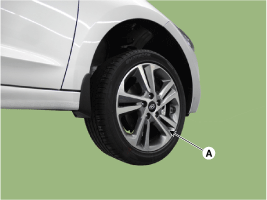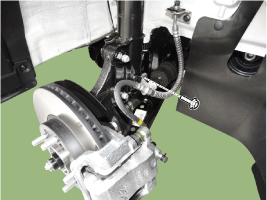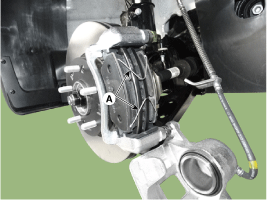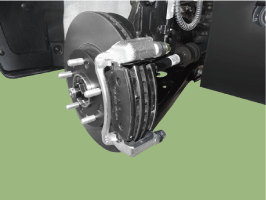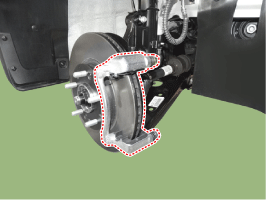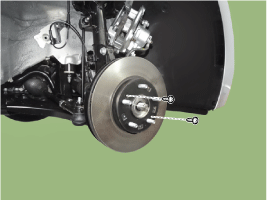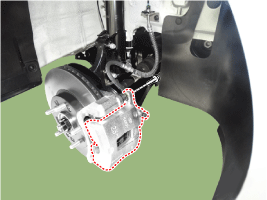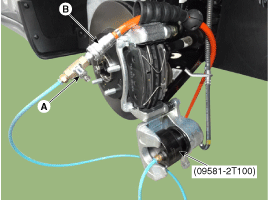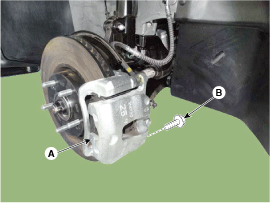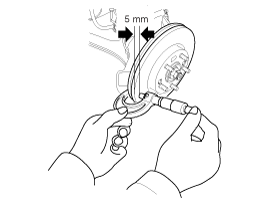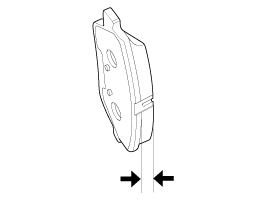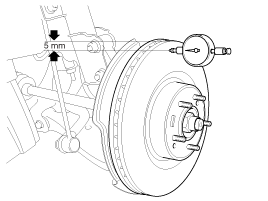Hyundai Elantra: Brake System / Front Disc Brake Repair procedures
| Removal |
| 1. |
Loosen the wheel nuts slightly.
Raise the vehicle, and make sure it is securely supported. |
| 2. |
Remove the front wheel and tire (A) from front hub .
|
| 3. |
Loosen the brake hose mounting bolt and then remove the brake hose bracket.
|
| 4. |
put down the caliper body by loosening the guided rod bolt.
|
| 5. |
Remove the pad return spring (A).
|
| 6. |
Remove the brake pad.
|
| 7. |
Separate the pad retainer. And remove the caliper carrier by loosening the caliper mounting bolts.
|
| 8. |
Remove the front brake disc by loosening the screws (A).
|
| Replacement |
| 1. |
Loosen the brake hose mounting bolt and then remove the brake hose bracket.
|
| 2. |
put down the caliper body by loosening the guided rod bolt.
|
| 3. |
Remove the pad return spring(A).
|
| 4. |
Replace the brake pad with a new one.
|
| 5. |
Install the pad return spring(A).
|
| 6. |
Use a SST (09581-2T100) when installing the brake caliper assembly.
|
| 7. |
Install the caliper body(A) then tighten the guide rod bolt(B).
|
| 8. |
Install the brake hose mounting bolt with the brake hose bracket at the shock absorber.
|
| Inspection |
| 1. |
Check the brake pads for wear and fade. |
| 2. |
Check the brake disc for damage and cracks. |
| 3. |
Remove all rust and contamination from the surface, and
measure the disc thickness at 8 points, at least, of same distance (5mm)
from the brake disc outer circle.
|
| 4. |
If wear exceeds the limit, replace the discs and pad assembly left and right of the vehicle. |
| 1. |
Check the pad wear. Measure the pad thickness and replace it, if it is less than the specified value.
|
| 2. |
Check that grease is applied, to sliding contact points and the pad and backing metal for damage.
|
| 1. |
Place a dial gauge about 5mm (0.2 in.) from the outer circumference of the brake disc, and measure the runout of the disc.
|
| 2. |
If the runout of the brake disc exceeds the limit specification, replace the disc, and then measure the runout again. |
| 3. |
If the runout does not exceed the limit specification,
install the brake disc after turning it 180° and then check the runout
of the brake disc again. |
| 4. |
If the runout cannot be corrected by changing the position of the brake disc, replace the brake disc. |
| Installation |
| 1. |
To install, reverse the removal procedure. |
| 2. |
Use a SST 09581-2T100) when installing the brake caliper assembly.
|
| 3. |
After installing, bleed the brake system.
(Refer to Brake System -"Brake System Bleeding")
(Refer to Brake system - "ABS System Bleeding")
(Refer to Brake system - "ESP System Bleeding") |
 Front Disc Brake Components and Components Location
Front Disc Brake Components and Components Location
Components
1. Caliper body2. Bleed screw3. Pad return spring4. Brake pad5. Caliper carrier6. Pad inner shim7. Pad retainer
...
 Rear Disc Brake Components and Components Location
Rear Disc Brake Components and Components Location
Components
1. Brake pad2. Pad return spring3. Caliper carrier4. Pad retainer5. Caliper body6. Return spring7. Stopper8. Operating lever9. Bleed screw
...
Other information:
Hyundai Elantra AD (2016-2020) Service Manual: Line Pressure Control Solenoid Valve Components and Components Location
Components Location
1. 26 Brake Control Solenoid Valve (26/B)2. 35R Clutch Control Solenoid Valve (35R/C)3. Underdrive Brake Control Solenoid Valve (UD/B)4. Overdrive Clutch Control Solenoid Valve (OD/C)5. SS-A Solenoid Valve (ON/OFF)6. Torque Converter Control Solenoid Valve (T/CON)7. Line Pre ...
Hyundai Elantra AD (2016-2020) Owners Manual: System Setting and Operation
System setting
• Setting Blind-Spot Safety function
The driver can activate the system by placing the ignition switch to the ON position
and by selecting 'User Settings → Driver Assistance → Blind-Spot Safety'.
- The BCW turns on and gets ready to be operated when 'Warning O ...

